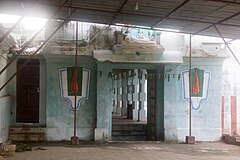Gajendra Varadha Temple
| Gajendra Varadha Perumal Temple | |
|---|---|
 |
|
| Geography | |
| Coordinates | 10°56′43″N 79°16′31″E / 10.94528°N 79.27528°ECoordinates: 10°56′43″N 79°16′31″E / 10.94528°N 79.27528°E |
| Country | India |
| State | Tamil Nadu |
| District | Thanjavur |
| Location | Kabisthalam |
| Culture | |
| Primary deity | Gajendra Varadhar(Vishnu) |
| Consort | Ramamanivalli(Lakshmi) |
| Festival deity | Damodara Narayanan(Vishnu) |
| Festival consort | Loganayaki(Lakshmi) |
| Temple tank | Gajendra, Kapila |
| Shrine | Gajanakriti |
| Poets | Tirumazhisai Alvar |
| Architecture | |
| Architectural styles | Dravidian architecture |
Gajendra Varadha Perumal Temple in Thirukkavithalam, a village in the outskirts of Papanasam in the South Indian state of Tamil Nadu, is dedicated to the Hindu god Maha Vishnu. Constructed in the Dravidian style of architecture, the temple is glorified in the Divya Prabandha, the early medieval Tamil canon of the Azhwar saints from the 6th–9th centuries AD. It is one of the 108 Divyadesam dedicated to Vishnu, who is worshipped as Gajendra Varadha and his consort Lakshmi as Ramamanivalli. The temple is one of the five Pancha-Kannan temples, where Krishna, an avatar of Vishnu is given prominence over the presiding deity.
The temple is believed to have been built by the Medieval Cholas of the late 8th century AD, with later contributions from Vijayanagar kings and Madurai Nayaks. A granite wall surrounds the temple, enclosing all its shrines and its bodies of water.
Gajendra Varadha is believed to have appeared to Gajendra the elephant also called Indrajumnan, the crocodile called Koohoo, Sage Parasara and Sri Anjaneya. Six daily rituals and four yearly festivals are held at the temple, of which the Gajendra Moksha Leela, celebrated during the Tamil month of Aadi (July–August), is the most prominent. The temple is maintained and administered by the Hindu Religious and Endowment Board of the Government of Tamil Nadu.
As per Hindu legend, King Indrajuman, who immersed himself in the worship of Lord Vishnu, failed to strengthen his army and lost his kingdom. While doing worship, he also did not observe the sage Durvasa (some sources claim it as Agasthya) who went along his way. The sage got irritated and cursed the king to be born as an elephant in his next birth. The king apologized to the sage for his negligence and moved by his innocence, the sage wished that he would continue to be a Vishnu devotee as an elephant and that Vishnu would bestow him goodwill. There was a demon by name Koohoo in the temple tank at this place, who troubled all who took bath in the tank. He was cursed by a sage to be born as crocodile in his next birth. The elephant Gajendra continued as a Vishnu devotee and while drinking water from the temple tank, his leg was grabbed the crocodile. The elephant cried in rescue calling the name "Adimulam" and Vishnu sent his discus to fend off the crocodile. Both the elephant and crocodile turned to their human form by the grace of Vishnu. Since Vishnu appeared heard to save the elephant Gajendra, he came to be known as Gajendara Varadar. Hanuman, the monkey lieutenant of Rama, (avatar of Vishnu) also worshiped Vishnu at this place and hence the place came to be known as Kabisthalam (kabi in Tamil indicated monkey).
...
Wikipedia

